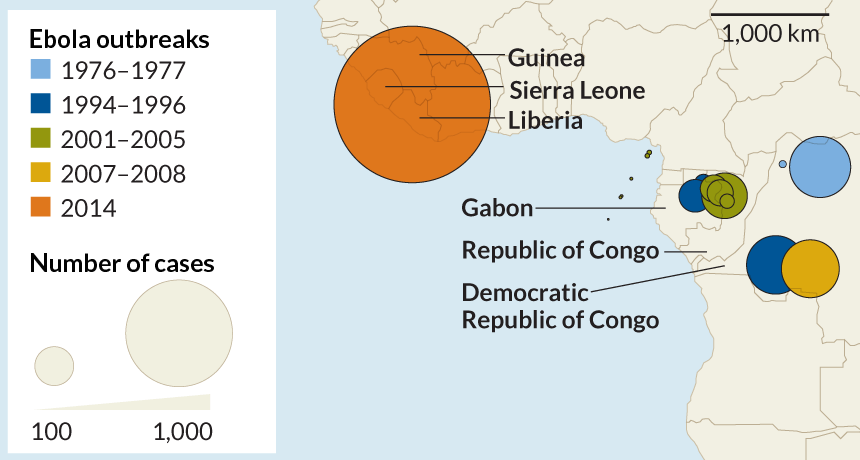
EBOLA EXPANSION West Africa is experiencing the largest Ebola outbreak ever recorded (map shows data as of August 19). A genetic analysis suggests that the virus causing the epidemic originated in Central Africa, where previous Ebola outbreaks have occurred. Source: S.K. Gire et al/Science 2014
redmal/iStockphoto, Adapted by E. Otwell
- More than 2 years ago
Genetic data confirm that the Ebola epidemic in West Africa is being spread from human to human, not through contact with infected animals.
The findings emphasize the need for better public health measures to keep the epidemic from spreading more widely among people rather than devoting more resources to tracking down animal reservoirs.
Genetic analyses also reveal that the Ebola virus strains infecting people in Guinea, Sierra Leone, Liberia and Nigeria originated in Central Africa in 2004, an international group of researchers reports August 28 in Science. The team sequenced the genomes of 99 Ebola viruses isolated from 78 patients during the first three weeks of the outbreak in Sierra Leone. Patterns of mutations in those viruses confirm epidemiological evidence that a healer who traveled to Guinea brought Ebola to Sierra Leone. Mourners at his funeral became infected and then spread the disease to others.
Analyzing viral DNA this quickly from an ongoing outbreak would have been unthinkable even five years ago, says Anthony Fauci, director of the U.S. National Institute of Allergy and Infectious Diseases in Bethesda, Md. Back then, it might have taken two years to compile and analyze the genetic data, but these researchers did it in two months. “Now, as we’re living through it, we’re able to trace the spread of the virus,” he says.
There is no indication that animals are infecting people, the researchers found. That finding supports evidence that the West African outbreak probably stemmed from a single instance of a person becoming infected, possibly from eating contaminated bushmeat, and the virus passing from person to person since then (SN Online: 8/11/14).
Ebola first struck humans in 1976 in Congo, and the virus that caused the disease was dubbed Zaire ebolavirus for the country’s former name. Since then, two dozen outbreaks have been recorded in Central Africa, Fauci says. (Congo is currently experiencing its seventh Ebola outbreak, which is unrelated to the one in West Africa, the World Health Organization said August 27.)
The West African epidemic — the first to strike that part of the continent — started last December in a village on the fringes of Guinea’s eastern rainforest, epidemiologists have determined. The version of the virus that made it to Sierra Leone branched from the Guinean strain in February, study coauthor Stephen Gire, an infectious disease researcher at Harvard University and the Broad Institute, and colleagues report. The virus is a variety of Zaire ebolavirus but carries 341 genetic changes not seen in previous outbreaks.
Some virus strains in Sierra Leone have been more successful than others, the researchers found. One particular mutation appeared in 50 patients, suggesting those people shared a chain of infection.
But it is not clear whether that mutation or any of the others alter the virus to make it more transmissible, says Sébastien Calvignac-Spencer, an evolutionary biologist at the Robert Koch Institute in Berlin. Some viral versions may rise to prominence by chance, he says, as might be the case if a mutant virus originated in a very popular person and many people caught the virus at his or her funeral.
But with so many people carrying Ebola — more than 3,000 people have been infected in West Africa and more than 1,500 have died — researchers worry the virus may develop mutations that change the structure or function of proteins. Such mutations might make the virus resistant to vaccines or therapies designed to combat it (SN Online: 8/20/14). And any mutation that hits a part of the viral genome used in DNA tests might make it difficult to diagnose the disease.
So far, mutations in the virus haven’t impeded treatment or testing, Fauci says. “It doesn’t interfere with anything practical now” but could become a problem if the epidemic isn’t stopped soon.
As of August 23, Sierra Leone had 881 confirmed cases, including 333 deaths and 236 survivors. Among the dead are five coauthors of the new study, all of whom were health care workers at Kenema Government Hospital where they had treated Ebola patients and gathered viral samples. Four other coauthors also contracted Ebola but survived and returned to work, Gire says.






